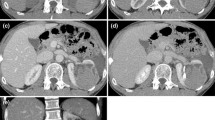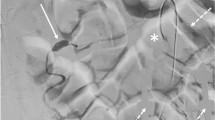Abstract
Purpose
Idiopathic spontaneous intraperitoneal haemorrhage (ISIH), historically known as abdominal apoplexy, is spontaneous haemorrhage due to rupture of an intra-abdominal visceral vessel in the absence of trauma or underlying pathology. It is an exceptionally rare condition, with mostly scattered case reports available. The aim of this study was to describe this rare condition, possible associated risk factors, and usefulness of multislice-CT (MS-CT) angiogram in its diagnosis prior to intervention.
Methods
A retrospective review of patients diagnosed with ISIH. Radiological records of haemoperitoneum from a single tertiary hospital in 2006–2013 were analysed, and the cases of ISIH were identified. Demographics (including pre-morbid hypertension status), abdominal aortic calcification as a measure of atherosclerotic changes, MS-CT angiogram +/− conventional digital subtraction angiograph images, surgical records and outcomes were reviewed.
Results
425 cases of haemoperitoneum were retrieved from hospital radiology database from 2006 to 2013, and 5 patients (1.1%) diagnosed with ISIH were identified (4 males, 1 female, mean age of 64 years). 4 out of 5 patients (80%) had a history of hypertension (mean 150/90 mmHg) and 3 patients had moderate abdominal aortic atherosclerosis. MS-CT angiogram was able to diagnose the bleeding source in 4 out of 5 patients, while the bleeding source remained occult in the last patient even with both MS-CT and traditional DSA angiography. Patients who underwent either embolization or surgery had no further re-bleeding in clinical follow up, ranging from 5 to 8 years.
Conclusions
Hypertension and abdominal aortic atherosclerosis appear to be associated risk factors for ISIH, and MS-CT angiogram has a high sensitivity in detecting the site of haemorrhage. An integrated angiographic and surgical approach is important in managing patients with ISIH.








Similar content being viewed by others
References
Cawyer JC, Stone CK (2011) Abdominal apoplexy: a case report and review. J Emerg Med 40(3):e49–e52
Matsumoto T, Yamagami T, Morishita H, et al. (2011) Transcatheter arterial embolization for spontaneous rupture of the omental artery. Cardiovasc Intervent Radiol 34:S142–S145
Suber WJ Jr, Cunningham PL, Bloch RS (1998) Massive spontaneous hemoperitoneum of unknown etiology: a case report. Am Surg 64:1177–1178
Hamilton JD, Kumaravel M, Censullo ML, et al. (2008) Multidetector CT evaluation of active extravasaion in blunt abdominal and pelvic trauma patients. RadioGraphics 28(6):1603–1616
Lockhart ME, Robbin ML, McNamara MM, Allon M (2004) Association of pelvic arterial calcification with arteriovenous thigh graft failure in haemodialysis patients. Nephrol Dial Transplant 19:2564–2569
Cauhoun DA, Jones D, Textor S, et al. (2008) Resistant hypertension: diagnosis, evaluation, and treatment. Hypertension 51:1403–1419
Carmeci C, Munfakh N, Brooks JW (1998) Abdominal apoplexy. South Med J 91:273–274
Lafferty CR, Pearson B (1940) Intraperitoneal hemorrhage in essential hypertension. Am J Surg 48(2):460–462
Jadav M, Ducheine Y, Brief D, et al. (2004) Abdominal apoplexy: a case study of the spontaneous rupture of the gastroepiploic artery. Curr Surg 61(4):370–372
Sun HP (2006) Preoperative diagnosis and successful surgical treatment of abdominal apoplexy—a case report. Tzu Chi Med J 18(6):452–455
Kleinsasser LJ (1970) Abdominal apoplexy. Report of two cases and review of the literature. Am J Surg 120:623–628
Carr SR, Dinsmore RC, Wilkinson NW (2001) Idiopathic spontaneous intraperitoneal hemorrhage: a clinical update on abdominal apoplexy in the year 2001. Am Surg 67:374–376
Bandri F, Packirisamy K, Aryasighe L, Al Suwaidi M (2012) Abdominal apoplexy: a rare case of spontaneous rupture of the superior mesenteric artery in a hypertensive patient. Int J Surg Case Rep 3(12):614–617
Author information
Authors and Affiliations
Corresponding author
Rights and permissions
About this article
Cite this article
Law, E.K.C., Lee, R.K.L., Hung, E.H.Y. et al. Radiological diagnosis and management of idiopathic spontaneous intra-abdominal haemorrhage (abdominal apoplexy): a case series. Abdom Imaging 40, 343–351 (2015). https://doi.org/10.1007/s00261-014-0220-z
Published:
Issue Date:
DOI: https://doi.org/10.1007/s00261-014-0220-z




